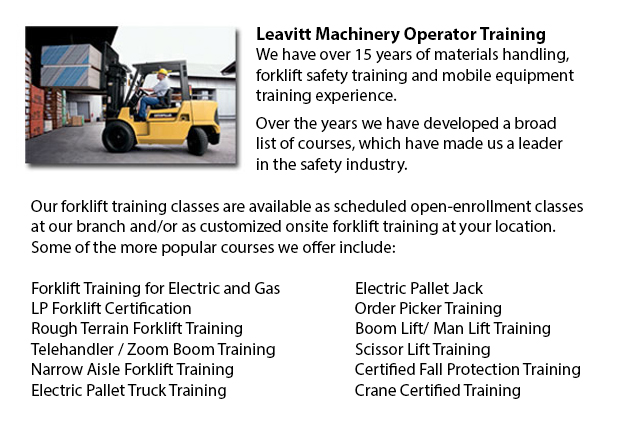
St Catharines Forklift Training Schools - The Benefits Of Taking One Of Our Forklift Training Schools
If you are looking for a job as an operator of a forklift, our regulatory-compliant forklift training Schools provide excellent instruction in many types and styles of lift trucks, lessons on pre-shift check, fuel types and handling of fuels, and safe utilization of a forklift. Practical, hands-on training assists those participating in acquiring basic operational skills. Course content comprises current rules governing the utilization of lift trucks. Our proven forklift Schools are designed to offer training on these types of trucks: counterbalanced forklift, powered pallet trucks and narrow isle forklift.
Whilst the lift truck is in operation, do not lower or raise the forks. Loads must not extend above the backrest. This is because of the danger of the load sliding back towards the operator. Inspect for overhead obstructions and ensure there is plenty of clearance before raising a load. Stay away from overhead power lines. When the load is lifted straight up, tilt it slightly back.
The lift truck is less steady if a load is in a raised position. Ensure that no one ever walks beneath the elevated fork. The operator should never leave the lift truck while the load is raised.
When handling pallets, forks should be high and level enough to go into the pallet and extend all the way below the load. The fork's width must provide equal distribution of weight.
Before unloading or loading the truck, set the brakes and chock the wheels. Floors have to be strong enough to support the weight of the forklift and the load combined. Fixed jacks can be installed to be able to support a semi-trailer which is not coupled to a tractor. The entrance door height must clear the height of the forklift by at least 5 cm. Mark edges of docks, rail cars or ramps and avoid them.
-
St Catharines Heavy Equipment Training Schools
St Catharines Heavy Equipment Training Schools - When selecting an operator training course, there are a lot of heavy equipment training schools to choose from. To be able to ascertain the qualifications you will attain, it is very important to explo... More -
St Catharines Heavy Equipment Operator Training
St Catharines Heavy Equipment Operator Training - Heavy equipment operator training facilities that offer quality standards within the business, offering field performance work and additional machine training are really sought after training features... More -
St Catharines Forklift Training Programs
St Catharines Forklift Training Programs - Are you looking for work as a driver of a forklift? Our regulatory-compliant mobile equipment operator training offers instruction in kinds of forklifts, pre-shift check, fuel kinds and handling of fuels, an... More -
St Catharines Heavy Equipment License
St Catharines Heavy Equipment License - A heavy equipment license can be obtained by taking a certification and preparation course at a private training school or a vocational school. This license would qualify you to operate various types of heavy e... More -
St Catharines Overhead Crane Safety Training
St Catharines Overhead Crane Safety Training - Overhead crane safety training equips operators with skills and knowledge regarding crane safety precautions, accident avoidance, materials handling, and equipment and stock protection. Trainees will lea... More -
St Catharines Scissor Lift Training
St Catharines Scissor Lift Training - Scissor lifts should be operated proficiently to be able to protect the safety of the equipment and the wellbeing of others within the workplace. Operators who are skilled are trained to drive the specific type o... More -
St Catharines Telescopic Training
St Catharines Telescopic Training - Telescopic Handlers are a kind of forklift, normally known as telehandlers. This machine has been increasing in popularity due to its greater lift heights and its versatility. It is often preferred over the convent... More -
St Catharines Boom Lift Certification
St Catharines Boom Lift Certification - Utilizing elevated work platforms allow for maintenance operations and work to be carried out at elevated work heights which were otherwise unreachable. Boom Lift Certification Training educates workers about t... More

Forklift Certification St Catharines
TOLL FREE: 1-888-254-6157
St Catharines, Ontario
forkliftcertificationstcatharines.com/
Email Us
About Us


